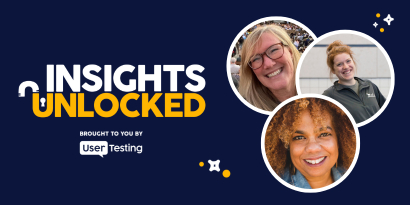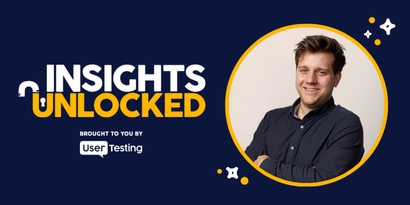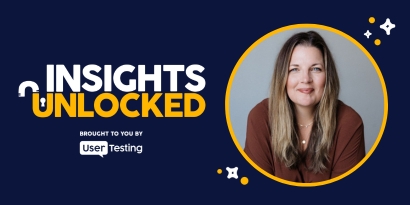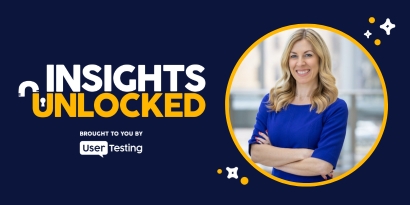Episode 21 | November 08, 2021
How customer feedback drives smarter product growth
Startup expert Emily Carrion shares how customer feedback fuels product development, drives growth, and builds trust—faster and smarter.
The power of customer feedback in product development: lessons from a startup veteran
What if the fastest way to build the right product isn't about moving fast and breaking things—but about slowing down to listen?
That’s exactly what Emily Carrion, VP of Marketing at Esper, believes. In this Insights Unlocked episode, she dives into how startups can use customer feedback in product development to scale smarter, innovate with confidence, and build customer trust from day one.
Drawing from her experience at six different startups—including her current role helping define a new category, “DevOps for devices”—Emily offers a masterclass in embedding user testing insights and customer experience research into every corner of a growing business.
Why startups should embrace early and frequent feedback
“Founders want to get to building as quickly as possible—and they think that because they have the problem, everyone else has the problem,” Emily says.
But skipping the discovery phase is one of the biggest mistakes early-stage companies can make.
Emily, who also advises early-stage startups, often sees a rush to build before teams truly understand the problem they’re solving. She suggests flipping the script: validate the problem first, using quick and cost-effective ways to gather early-stage product feedback.
“Test those initial assumptions. Nail down who that ideal customer is and then get feedback from those actual humans.”
She highlights platforms like UserTesting, where even a quick test can surface game-changing insights, “You’ll learn fast if your idea actually resonates.”
ON-DEMAND WEBINAR
Tactical (and practical) tips to get fast feedback for better marketing
In this webinar you’ll:
- Learn strategies for getting efficient feedback on copy, language, and messaging
- Optimize your practice around connecting with your customers' moods, needs, and experiences as the business environment changes
- Take away best practices on understanding how rich media such as video and audio is resonating
Building empathy through the voice of the customer
Emily believes human-centered design starts with simply listening to people—whether they’re customers or new hires. At Esper and her previous companies, she often uses video-based feedback to help product and engineering teams empathize with users’ struggles.
In one example, she shared how real-time customer insights changed everything for a cybersecurity product team that had dismissed complaints about a complex VPN connection process.
“So we spun up a test on UserTesting. People were literally swearing in the recordings because they couldn’t figure it out. And once our engineers saw that—they couldn’t unsee it. It was no longer my opinion versus theirs.”
“Seeing the world through your customer’s eyes changes everything," she said. "It turns opinions into evidence.” This kind of customer-centric innovation ensures teams don’t waste time guessing at what’s wrong. Instead, they focus their energy where it will have the most impact—an essential tactic in fast-moving startup environments.
Turning customer feedback into a company-wide habit
One of Emily’s biggest points? Customer feedback isn’t just a job for support or success teams. Everyone—from marketing to engineering—should be connected to the customer experience.
“It really needs to be in the DNA of the whole company,” she explains. “Whether you call it customer obsession or just caring about the people using your product—it needs to be part of every decision.”
At Esper, that starts with making customer stories widely accessible. She frequently records Zoom calls with clients and shares them across departments, giving internal teams firsthand exposure to customer journey insights.
“Recording conversations lets the whole organization hear directly from the customer. It’s one of the biggest gifts you can give your team.”
This democratization of feedback not only builds empathy but also helps teams spot patterns and prioritize product development based on what users actually need.
Content strategy powered by real user feedback
As a marketer, Emily doesn’t just use customer feedback to refine product features—she uses it to shape messaging, campaigns, and even the company’s content roadmap.
Esper is currently building what she calls a “media company” to educate customers on best practices in device management and feedback-driven development. To make sure they’re creating content that resonates, Emily talks to customers directly.
“My absolute favorite thing to do is get a half-hour with a customer and just listen: What do you care about? What are your goals? Where do you get your information? Then I use that to go find ten more people just like them.”
These conversations uncover language, mental models, and pain points that can inform everything from ad copy to blog posts to event strategy. It’s customer-led growth in action.
Small feedback loops, big results
Whether she’s working on a product launch or exploring a new brand campaign, Emily leans on iterative product design and continuous user feedback to ensure alignment with customer needs.
Instead of assuming what messaging will land, she encourages her team to test early and often: “Try the web page. See where people get stuck. Watch the heat maps. Let the data guide you.”
In B2B marketing—where buying cycles are long and decision-makers are many—this feedback becomes a crucial advantage.
It’s not just about the tactical wins, though. Emily also points out how positive feedback can become a powerful internal motivator: “When a customer says, ‘You’re our top vendor,’ or ‘You made my job easier,’ that’s fuel for the whole team.”
From qualitative insight to strategic alignment
Feedback doesn’t always have to come from elaborate testing setups. In Emily’s world, some of the most powerful insights come from simple, open-ended conversations.
She uses these to:
- Identify trends across customers in different industries
- Uncover language customers use to describe their problems
- Spot unmet needs that might influence the product roadmap
- Build buyer personas rooted in reality—not assumptions
By analyzing these inputs, her team can align product, sales, and marketing efforts to focus on what truly matters to the customer—without guesswork.
“When you hear the same thing from three or four customers, that’s not a coincidence—it’s a signal.”
Remote work made customer connections easier
Emily sees a silver lining in the shift to remote work: “It’s actually easier to get feedback now.”
Without the need for travel or formal setups, customers are more open to quick Zoom chats or asynchronous feedback sessions. She uses these moments to build relationships and gather insight—often recording them for broader internal distribution.
“Now, more people across the company can hear the customer’s voice directly. You can’t replicate that by just taking notes.”
Plus, remote tools make it easier to understand how customers are interacting with the product in different environments—especially relevant in Esper’s world of edge devices and IoT.
Making feedback part of the culture
To wrap things up, Emily stresses that integrating feedback isn’t just a one-time project—it’s a cultural commitment.
Whether you're a three-person startup or a scaling enterprise, your ability to adapt, innovate, and grow depends on how well you understand your customers—and that understanding only comes from listening.
“We don’t have time to guess," Emily said. "The fastest path to building something great is through your customers. Just ask them.”
Episode links:
- 7 strategies for collecting product feedback: Explore effective methods for gathering customer insights throughout the product development lifecycle to ensure your offerings align with user needs.
- How to incorporate customer experience feedback into the product development process: Learn how integrating customer feedback at various stages can enhance usability, reduce risks, and create solutions that resonate with your audience.
- How to build customer-centric products with fast feedback loops: Understand the importance of integrating quick feedback mechanisms into your product development process to make informed decisions and reduce costly rework.
- 4 tips for customer-centric digital product development: Learn actionable strategies to ensure your digital products are aligned with customer needs through continuous user research and feedback integration.
- The ultimate guide to user-centric product design: Dive into key principles of user-centric design and learn how to incorporate user feedback at every stage to create products with confidence.










